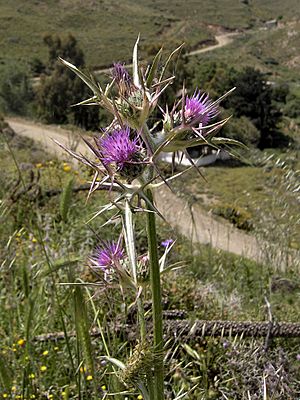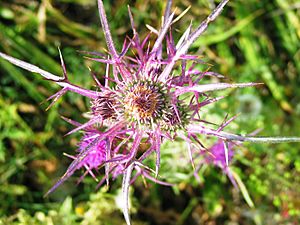Syrian thistle facts for kids
Quick facts for kids Syrian thistle |
|
|---|---|
 |
|
| Scientific classification | |
| Genus: |
Notobasis
|
| Species: |
syriaca
|
| Synonyms | |
|
|
The Syrian thistle (scientific name: Notobasis syriaca) is a type of flowering plant. It belongs to the daisy family, called Asteraceae. This plant naturally grows in the Mediterranean region and the Middle East. You can find it from places like Madeira, the Canary Islands, Morocco, and Portugal all the way east to Egypt, Iran, and Azerbaijan.
Contents
About the Syrian Thistle
The Syrian thistle is an annual plant. This means it completes its whole life cycle, from seed to flower to seed, in just one year. It often grows in areas that are like semi-deserts.
What the Syrian Thistle Looks Like
This plant can grow to be about 30 to 100 centimeters (about 1 to 3 feet) tall. Its leaves grow in a spiral pattern around the stem. They are deeply cut and have a grey-green color with white lines. The edges and tips of the leaves have sharp spines.
The flowers are purple. They grow together in a tight bunch called a flowerhead (or capitulum). Each flowerhead is about 2 centimeters across. Several spiny leaves are found at the base of the flowerhead.
Where the Syrian Thistle Grows
The Syrian thistle is native to a wide area. This includes the Mediterranean region and the Middle East. It grows in countries like Madeira, the Canary Islands, Morocco, Portugal, Egypt, Iran, and Azerbaijan.
Sometimes, a plant can start growing in a new place where it wasn't originally found. This is called being naturalized. The Syrian thistle has become naturalized in Australia.
How People Use It
On the Greek island of Crete, the Syrian thistle is known as agavanos (αγκάβανος). Local people there sometimes eat the young, tender shoots of the plant. They peel the shoots first and then eat them raw.
See also
 In Spanish: Notobasis syriaca para niños
In Spanish: Notobasis syriaca para niños


